

Ermine,
vair and their cousins
by
Mike Oettle
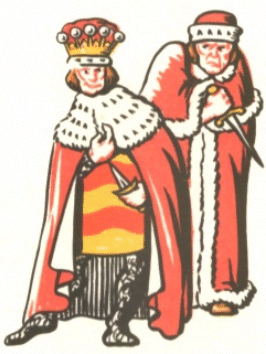
FURS, during the Middle Ages, symbolised people of authority.
Kings and nobles – and in later years, senior judges, too – wore ermine linings to their robes. The lining would be turned out at the edge of the garment, partly as a means of showing off, but officially merely to finish the garment.
A little less costly was vair, also used to line garments, and made up of squirrel pelts.
With a handful of exceptions, the application of furs in heraldry is a stylisation, not only of these two very familiar varieties, but of further variations on each kind – some of them highly original.
Von Volborth[1] speculates: “These patterns in fur probably go back to shields which in the infancy of heraldry were covered with real fur.” However, this seems unlikely. Even if an armiger were wealthy enough not to have to worry about the cost of dressing his shield in fur, such a finish would be slashed to ribbons in the shield’s first use in battle.
One exception mentioned is a form of vair (or at least, it is traditionally held to be a variation on vair) that is found in German heraldry. In German it is called Kursch, and Fox-Davies[2] translates it as “vair bellies”. He writes that “it is usually shown to be hairy and represented brown”.
But he also speculates that it might be the same as one of two oddities noted in Italian heraldry, and recorded by Woodward.[3] These are named as plumeté and papelonné – although many of the instances given come from Italy, they are named in Fox-Davies only in their French form. Fox-Davies quotes Woodward:

“In Plumeté the field is apparently covered with feathers. Plumeté d’argent et d’azur is the coat of CEBA (note that these are the tinctures of Vair); SOLDONIERI of Udine, Plumeté au natural [sic] but the SOLDONIERI of Florence bore: Vairé argent and sable with a bordure chequy or and azure); TENREMONDE of Brabant: Plumeté or and sable. In the arms of the SCALTENIGHI of Padua, the BENZONI of Milan, the GIOLFINI, CATANEI, and NUVOLONI of Verona, each feather of the plumeté is said to be charged with an ermine spot sable.
“The bearing of Papelonné is more frequently found: in it the field is covered with what appear to be scales, the heraldic term papelonné being derived from a supposed resemblance of these scales to the wings of butterflies; for example the coat of MONTI: Gules, papelonné argent. DONZEL at Besançon bears: Papelonné d’or et de sable. It is worthy of note that DONZÉ of Lorraine used: Gules, three bars wavy or. The FRANCONIS of Lausanne are said to bear: de Geueles papelonné d’argent, and on a chief of the last a rose of the first, but the coat is otherwise blazoned Vaire gules and or, &c. The coat of ARQUINVILLIERS, or HARGENVILLIERS, in Picardy, of d’Hermine papelonné de geules (not being understood, this has been blazoned ‘semé of caltraps’). So also the coat of CHEMILLÉ appears in French books of blazon indifferently as: d’Or papelonné de geueles; and d’Or semé de chausse-trapes de geules. GUÉTTEVILLE DE GUÉNONVILLE is said to bear: d’Argent semé de chausse-trapes de sable, but it is more probable that they simply bear: Argent papelonné de sable. The BARISONI of Padua bear: Or, a bend of scales, bendwise argent, on each scale an ermine spot sable, the bend bordered sable. The ALBERICI of Bologna bear: Papelonné of seven rows, four of argent, three of or; but the ALBERGHI of the same city: Papelonné of six rows, three of argent, as many of gules. The connection with vairé is much clearer in the latter than in the former. CAMBI (called FIGLIAMBUCHI), at Florence, carried: d’Argent, papelonné de geueles; MONTI of Florence and Sicily, and RONQUEROLLES of France the reverse.
“No one who is familiar with the licence given to themselves by armorial painters and sculptors in Italy, who were often quite ignorant of the blazons they depicted, will doubt for a moment the statement that Papelonné was originally a corruption from or perhaps is simply ill-drawn Vair.”
This is a long digression (without illustrations, which is worse), but it serves to underline the relationship between obscure feather-like fields and the fur group – which finds a curious parallel in an Austrian coat of arms which was recently the subject of agitated discussion on the Flags of the World discussion list.
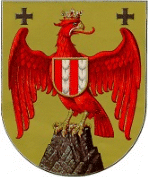
The arms in question are of the Bundesland (federal state) of Burgenland, in which an eagle appears with a breast-shield blazoned paly of gules and Kursch. Austrian heraldist Dr Peter Diem was amused (and perhaps mildly offended) that I had remarked on the Kursch pallets as resembling a field of ostrich feathers, but in the light of the above discussion the relationship does not seem entirely far-fetched. I leave it to the viewer: have a look at the large illustration of these arms at International Civic Arms, and judge for yourself.
The great advantage of heraldic furs is their versatility. Fox-Davies writes:
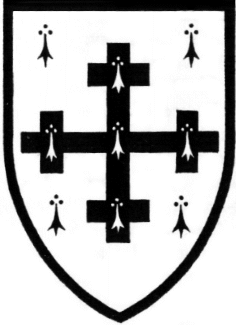
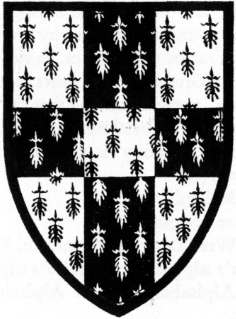
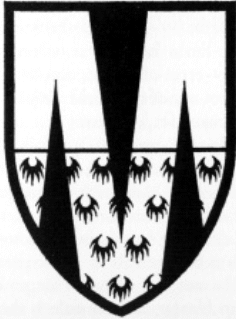
“Furs may be placed upon either metal or colour, as may also any charge which is termed proper. German heralds describe furs and natural colours as amphibious. It is perfectly legitimate to place fur upon fur, and though not often found, numbers of examples can be quoted.”
This opinion is not shared by L G Pine. Writing about the colour rule in the Encyclopædia Britannica, he remarks:
“It is considered bad practice to put a colour upon a colour, a metal upon a metal, or a fur upon a fur. Many examples of such bad heraldry are found in old records, but in this as in other instances, the rules now prevalent grew up only very gradually.”
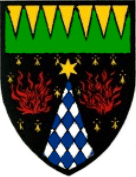
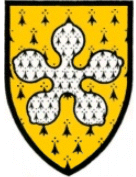
Shown here are four examples of fur upon fur. First are the arms of Durrant of Scottowe, featuring a cross-crosslet in ermines on a field of ermine. Next are the arms of Richard del Brugge (or Bruges), appointed Lancaster Herald in 1380 and Lancaster King of Arms in 1399, who bore: ermine, a cross quarter-pierced ermines, and lastly the arms of Hulse: Per fess argent and ermine, three piles, one issuant in chief and two in base, sable.. The contrast in Hulse’s arms is perhaps less striking, but the main visual element is the three piles.
At right is (to my mind) a most simple and effective design, the arms of Flower, of Sussex: erminois, a cinquefoil ermine. The final example is not one of fur on fur, but of a inverted pile lozengy in argent and azure on a field of pean. I include it because it has the same visual effect as a pile in vair would have – the colours of the pile would be the same. The shield might be a trifle busy, with the star at the tip of the pile and the two lowes of flame, but it is nonetheless quite striking.
The colour rule exists because it makes common sense – the example given elsewhere of a red lion on blue seems to me to be self-evident – but to my eye the contrast between these furs is apparent, and even in the case of Flower’s cinquefoil, it seems quite adequate . . . indeed, it is quite pleasing.
